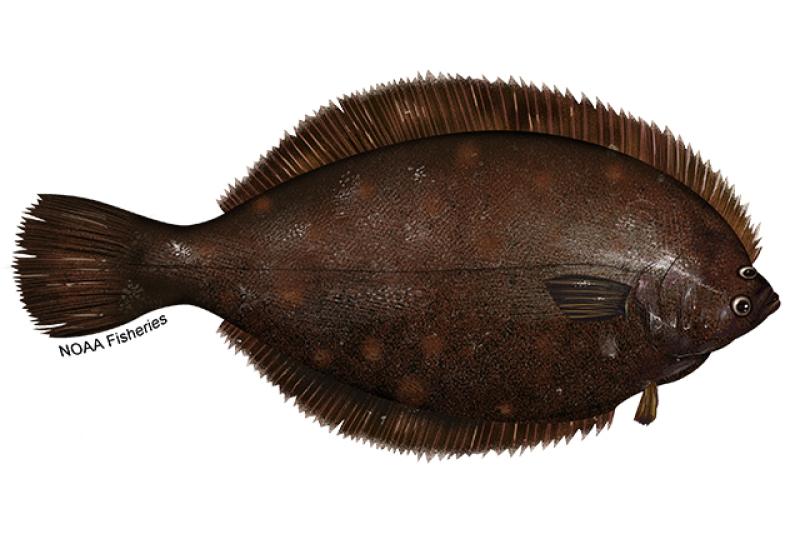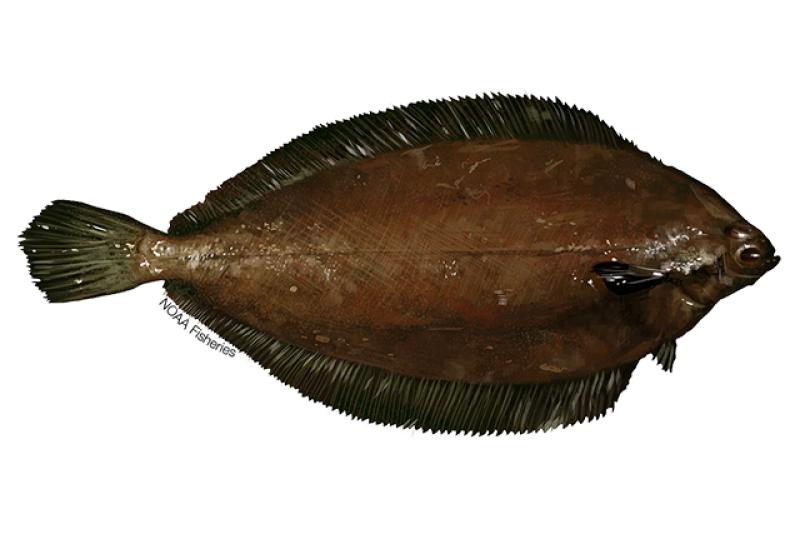About the Species
Although populations are well below target levels, U.S. wild-caught Atlantic halibut is still a smart seafood choice because it is sustainably managed under a rebuilding plan that allows limited harvest by U.S. fishermen.

Population
The stock is overfished, but the fishing rate established under a rebuilding plan promotes population growth.

Fishing Rate
Overfishing status is unknown, but catch is at recommended level.

Habitat Impact
Trawl gear used to harvest Atlantic halibut have minimal or temporary effects on habitat. Area closures and gear restrictions protect sensitive habitats from bottom trawl gear. Hook and line gear has little or no impact on habitat.

Bycatch
Regulations are in place to minimize bycatch.
Population Status
- The Atlantic halibut stock is at a very low level. Fishing is still allowed, but at reduced levels.
- According to the 2022 stock assessment, the Atlantic halibut stock is overfished. Summary stock assessment information can be found on Stock SMART.
Appearance
- Atlantic halibut can be distinguished from other right-eyed flounders by their large size, concave caudal fin, large, gaping mouth, and arched lateral line.
- One of the largest fish found in the Gulf of Maine.
Biology
- Atlantic halibut is the largest species of flatfish in the world.
- Atlantic halibut can reach up to 15 feet in length
- The largest Atlantic halibut recorded was taken off Cape Ann, Massachusetts, and weighed 615 pounds (eviscerated with the head still attached). It likely weighed 700 pounds when it was alive.
- It is a long-lived, late-maturing species that can live up to 50 years.
- Average age at maturity is about 10 years.
- Full grown females average 100 to 150 pounds, while males tend to be smaller.
- Females are batch spawners, producing several batches of eggs each year.
- In Canadian waters, Atlantic halibut spawn from late winter to early spring, while spawning can last through September for fish from Georges Bank to the Grand Banks.
- Halibut food preferences vary by fish size: smaller fish (up to 12 inches in length) feed almost exclusively on invertebrates. The proportion of fish in the diet increases as the fish grow in size until they feed almost exclusively on fishes when they reach approximately 31 inches.
Where They Live
Range
- Atlantic halibut are found from Labrador and Greenland to Iceland, and from the Barents Sea south to the Bay of Biscay and Virginia.
- In U.S. waters, halibut is most common in the Gulf of Maine.
Habitat
- Atlantic halibut are found in the temperate and arctic waters of the northern Atlantic.
- They live in coastal to upper slope areas.
- Atlantic halibut are demersal fish that live on or near sand, gravel or clay bottoms at depths of between 160 and 6,560 feet.
Fishery Management
- NOAA Fisheries and the New England Fishery Management Council manage Atlantic halibut.
- Atlantic halibut, along with other groundfish in New England waters, are managed under the Northeast Multispecies Fishery Management Plan, which includes:
- Permitting requirements for commercial vessels.
- Separate management measures for recreational vessels.
- Year-round and seasonal area closures to protect spawning fish and habitat.
- Minimum fish sizes to prevent harvest of juvenile fish.
- Annual catch limits, based on best available science.
- An optional sector (catch share) program can be used for cod and other groundfish species. The sector program allows fishermen to form harvesting cooperatives and work together to decide when, where, and how they harvest fish.
- A rebuilding plan to rebuild the stock to the target population level is in place with a target date of 2055.
Harvest
- Commercial fishery:
- In 2023, commercial landings of Atlantic halibut totaled 77,800 pounds and were valued at approximately $493,500, according to the NOAA Fisheries commercial fishing landings database.
- Regulations include a minimum fish size and a limit of one fish per vessel per trip in federal waters.
- Gear types, habitat impacts, and bycatch:
- Halibut are commonly harvested using trawl nets, bottom longlines, and rod and reel.
- Trawl gear used to harvest halibut can impact habitat, depending on where they are used. Trawl gear can incidentally catch other fish and marine mammals.
- Longlines, and rod and reel used to harvest halibut have little to no impact on habitat.
- Regulations close key areas to fishing year-round or seasonally to protect habitat and spawning aggregations.
- Restrictions on the size of gear that makes contact with the bottom in certain areas also help reduce habitat impacts.
- Fishermen follow a number of strict regulations and use modified fishing gear to reduce bycatch of other species.
- Recreational fishery:
- Halibut are sometimes targeted by recreational anglers, but are most often encountered when targeting other groundfish species like cod and haddock.
- Regulations include a minimum fish size and a limit of one fish per vessel per trip in federal waters.
Scientific Classification
- Atlantic halibut are found from Labrador and Greenland to Iceland, and from the Barents Sea south to the Bay of Biscay and Virginia.
- In U.S. waters, halibut is most common in the Gulf of Maine.
- Atlantic halibut are found in the temperate and arctic waters of the northern Atlantic.
- They live in coastal to upper slope areas.
- Atlantic halibut are demersal fish that live on or near sand, gravel or clay bottoms at depths of between 160 and 6,560 feet.
Fishery Management
- NOAA Fisheries and the New England Fishery Management Council manage Atlantic halibut.
- Atlantic halibut, along with other groundfish in New England waters, are managed under the Northeast Multispecies Fishery Management Plan, which includes:
- Permitting requirements for commercial vessels.
- Separate management measures for recreational vessels.
- Year-round and seasonal area closures to protect spawning fish and habitat.
- Minimum fish sizes to prevent harvest of juvenile fish.
- Annual catch limits, based on best available science.
- An optional sector (catch share) program can be used for cod and other groundfish species. The sector program allows fishermen to form harvesting cooperatives and work together to decide when, where, and how they harvest fish.
- A rebuilding plan to rebuild the stock to the target population level is in place with a target date of 2055.
Harvest
- Commercial fishery:
- In 2023, commercial landings of Atlantic halibut totaled 77,800 pounds and were valued at approximately $493,500, according to the NOAA Fisheries commercial fishing landings database.
- Regulations include a minimum fish size and a limit of one fish per vessel per trip in federal waters.
- Gear types, habitat impacts, and bycatch:
- Halibut are commonly harvested using trawl nets, bottom longlines, and rod and reel.
- Trawl gear used to harvest halibut can impact habitat, depending on where they are used. Trawl gear can incidentally catch other fish and marine mammals.
- Longlines, and rod and reel used to harvest halibut have little to no impact on habitat.
- Regulations close key areas to fishing year-round or seasonally to protect habitat and spawning aggregations.
- Restrictions on the size of gear that makes contact with the bottom in certain areas also help reduce habitat impacts.
- Fishermen follow a number of strict regulations and use modified fishing gear to reduce bycatch of other species.
- Recreational fishery:
- Halibut are sometimes targeted by recreational anglers, but are most often encountered when targeting other groundfish species like cod and haddock.
- Regulations include a minimum fish size and a limit of one fish per vessel per trip in federal waters.
Scientific Classification
| Kingdom | Animalia | Phylum | Chordata | Class | Actinopterygii | Order | Pleuronectiformes | Family | Pleuronectidae | Genus | Hippoglossus | Species | hippoglossus |
|---|
Last updated by NOAA Fisheries on 03/25/2025
Featured News
 The NOAA research vessel Gloria Michelle conducts groundfish surveys in New England, an important mission to support science-based fisheries management. Photo credit: NOAA Fisheries
The NOAA research vessel Gloria Michelle conducts groundfish surveys in New England, an important mission to support science-based fisheries management. Photo credit: NOAA Fisheries
As Fishing Season Opens, NOAA Implements Emergency Action to Ensure Uninterrupted Northeast Fisheries
 Juvenile coho salmon. Credit: iStock
Juvenile coho salmon. Credit: iStock
NOAA Fisheries Releases 2023 Status of Stocks
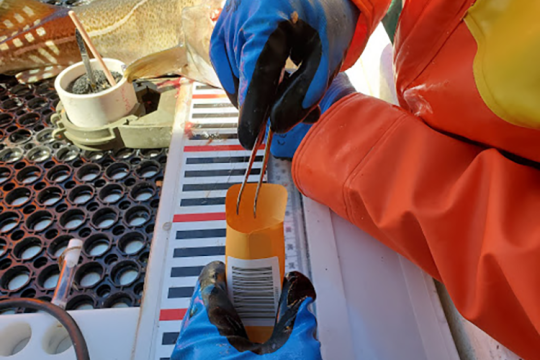
2021 Spring Gulf of Maine Cooperative Bottom Longline Survey Concludes
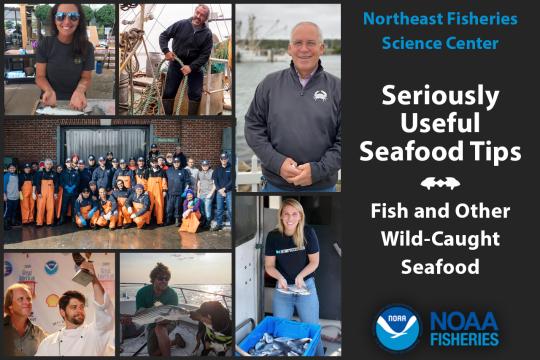
Seriously Useful Seafood Tips: Fish and Other Wild-Caught Seafood
Seafood Facts

Is Atlantic Halibut Sustainable?
Although populations are well below target levels, U.S. wild-caught Atlantic halibut is still a smart seafood choice because it is sustainably managed under a rebuilding plan that allows limited harvest by U.S. fishermen.
Availability
Year-round.
Source
Wild-caught from Maine to Connecticut.
Taste
Halibut has a very mild, sweet taste.
Texture
A lean fish with fine-grained, dense meat. When cooked, the meat is firm yet flaky and tender.
Color
Uncooked, white and almost translucent. It should not look dull, yellowish or dried out. When cooked, the meat is white.
Health Benefits
Halibut is low in saturated fat and sodium, and is a very good source of protein, niacin, phosphorus, and selenium.
Nutrition Facts
Servings: 1; Serving Weight: 100 g (raw); Calories: 110; Protein: 20.81 g; Total Fat: 2.29 g; Total Saturated Fatty Acids: 0.325 g; Cholesterol: 32 mg; Selenium: 36.5 mcg; Sodium: 54 mgHalibut Recipes
Looking for some ways to add white fish like halibut into your diet? If you need some cooking inspiration, browse these recipes for potato crusted halibut, battered white fish, and more!
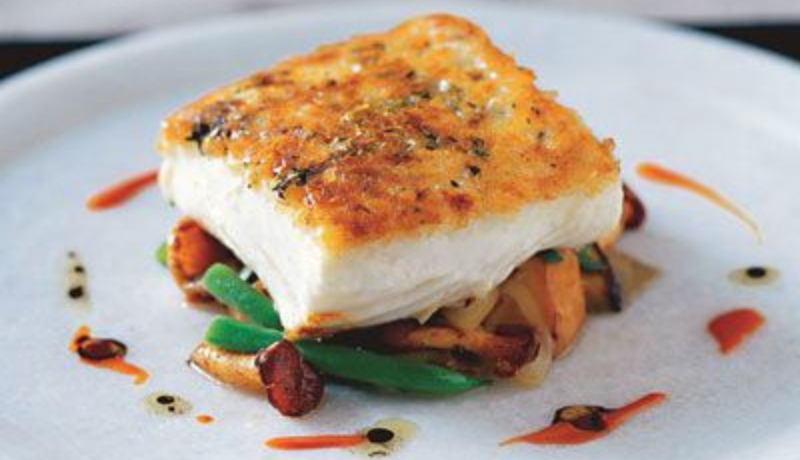
Last updated by NOAA Fisheries on 03/25/2025
Seafood News
 Celebrate Culinary Arts Month with a sustainable seafood recipe for every month of the year.
Celebrate Culinary Arts Month with a sustainable seafood recipe for every month of the year.
What Your Birth Month Says About Your Next Seafood Recipe
 Fresh-caught taʻape on ice. Credit: Conservation International Hawaiʻi.
Fresh-caught taʻape on ice. Credit: Conservation International Hawaiʻi.
Reducing Waste and Feeding Communities in Hawaiʻi with a Whole Fish Approach
 Chef Tyler Hadfield’s Curried Skate Wings with Tomato-Masala Chutney
Chef Tyler Hadfield’s Curried Skate Wings with Tomato-Masala Chutney
Ring In the New Year With These Crowd-Favorite Seafood Recipes
 NOAA Fisheries, in collaboration with Blue Ocean Mariculture, is conducting a multi-year pilot study to evaluate observational methods and tools for studying Hawaiian monk seal behavior. Courtesy of Blue Ocean Mariculture
NOAA Fisheries, in collaboration with Blue Ocean Mariculture, is conducting a multi-year pilot study to evaluate observational methods and tools for studying Hawaiian monk seal behavior. Courtesy of Blue Ocean Mariculture
AI Meets Aquaculture to Study Hawaiian Monk Seal Interactions With Net Pens
Management Overview
Atlantic halibut is managed under the Northeast Multispecies (Groundfish) Fishery Management Plan (FMP) along with 12 other species of groundfish. Collectively, these 13 species are referred to as the Northeast multispecies complex.
Learn more about the Northeast multispecies complex and its management.
Last updated by NOAA Fisheries on 03/25/2025
Data & Maps
Research
Gulf of Maine Bottom Longline Survey
Our Gulf of Maine Bottom Longline Survey collects data on species that prefer rocky habitats—a habitat not efficiently sampled with trawl gear used in bottom trawl surveys
Last updated by NOAA Fisheries on 03/25/2025


